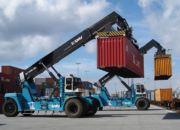Calculating ROI When Investing in Forklifts for Businesses
Optimizing logistics operations and warehouse management is key for businesses to improve production and business efficiency. Investing in forklifts is one of the effective solutions to help businesses achieve this goal. However, before making an investment decision, businesses need to carefully consider the cost and benefit factors. Calculating ROI (Return on Investment) will help businesses make informed investment decisions and optimize profits.
What is ROI?
ROI is a financial metric that measures the ratio of net profit to investment costs. This ratio indicates the effectiveness of an investment. The higher the ROI, the more profitable the investment.
Why is it necessary to calculate ROI when investing in forklifts?
Calculating ROI when investing in forklifts brings many important benefits to businesses:
Evaluate investment efficiency: ROI helps businesses determine the profitability of forklift investments, thereby making reasonable investment decisions.
Compare investment options: Businesses can calculate ROI for different types of forklifts or compare buying forklifts with renting forklifts to choose the optimal option.
Optimize resources: Calculating ROI helps businesses allocate resources effectively, focusing on investments that bring the highest returns.
Improve management efficiency: Tracking ROI helps businesses evaluate asset management efficiency, thereby improving operational processes.
Factors to consider when calculating forklift ROI
To calculate ROI accurately, businesses need to consider all cost and benefit factors related to forklift investment.
Initial investment costs:
Forklift purchase price: This is the largest cost when investing in a forklift. Forklift prices depend on many factors such as brand, load capacity, engine type, features, etc.
Transportation and installation costs: This cost includes transporting the forklift from the supplier to the business’s warehouse, as well as the cost of installing and adjusting the forklift.
Operator training costs: To ensure safety and operational efficiency, businesses need to invest in training for employees to use forklifts.
Forklift operating costs:
Fuel (or electricity): The cost of fuel (diesel, gas, gasoline) or electricity consumed during forklift operation.
Maintenance: Forklifts need to be maintained regularly to ensure stable operation and prolong their lifespan. This cost includes changing oil, air filters, checking electrical and hydraulic systems, etc.
Repair: During use, the forklift may experience breakdowns that need to be repaired. Repair costs depend on the extent of damage and the price of replacement parts.
Operator labor costs: Including salary, insurance and allowances for forklift operators.
Storage and preservation costs of the vehicle: Businesses need to have space to store and preserve the forklift when not in use.
Benefits of investing in forklifts:
Increased labor productivity: Forklifts help transport and load goods faster and more efficiently than manual methods, thereby increasing labor productivity.
Reduced labor costs: Using forklifts helps reduce the number of workers needed to perform the same workload, saving labor costs.
Improved occupational safety: Forklifts help reduce occupational accidents due to manual transportation, protecting workers’ health.
Optimizing warehouse space: Forklifts can stack goods high, making more efficient use of warehouse space.
Improve warehouse management efficiency: Combined with a modern warehouse management system, forklifts help control goods better, minimize errors and losses.
Increase professionalism: Using forklifts helps enhance the professional image of the business in the eyes of customers and partners.
Formula for calculating forklift ROI
The formula for calculating forklift ROI is as follows:
ROI = (Net profit from using forklift – Total investment and operating costs) / Total investment and operating costs x 100%
Where:
Net profit from using forklifts: Calculated by the increased efficiency in revenue, reduced labor costs, minimized goods damage, etc. due to the use of forklifts.
Total investment and operating costs: Including all the costs mentioned above.
Illustrative example:
A business invests in buying an electric forklift for 500 million VND. Shipping and installation costs 10 million VND. The cost of training staff is 5 million VND. The annual operating cost (including electricity, maintenance, repair, labor) is estimated at 50 million VND. After using the forklift, labor productivity increased by 30%, helping businesses increase revenue by 100 million VND/year and reduce labor costs by 20 million VND/year.
Calculate ROI after 1 year:
Total investment cost: 500 + 10 + 5 = 515 million VND
Total operating cost for the first year: 50 million VND
Net profit for the first year: 100 + 20 = 120 million VND
ROI = (120 – 50 – 515) / (50 + 515) x 100% = -77.67%
Comment: In this example, the ROI after 1 year is negative, showing that the investment has not yet been effective. However, it should be noted that this is only the calculation result after the first year. Businesses need to continue to track ROI in the following years to fully assess the effectiveness of the investment.
Other methods for evaluating the effectiveness of forklift investment
In addition to ROI, businesses can use other methods to evaluate the effectiveness of forklift investment:
Payback period: The time required to recover the initial investment. The shorter the payback period, the more effective this investment is.
Net Present Value (NPV): Assesses the present value of future cash flows. A positive NPV indicates that the investment project is profitable.
Internal Rate of Return (IRR): The discount rate that makes the NPV of the project equal to 0. The higher the IRR, the more profitable the project.
Advice for businesses when investing in forklifts
Determine actual needs: Before investing, businesses need to clearly define the need to use forklifts (type of goods, load capacity, working environment, etc.) to choose the right type of vehicle.
Choose a reputable supplier: Choose a reputable and experienced supplier that provides quality products and good after-sales service.
Professional operator training: Invest in training for forklift operators to ensure safety and efficient use.
Perform regular maintenance: Maintain the forklift according to the manufacturer’s schedule to prolong the life of the vehicle and minimize repair costs.
Compare prices and services: Compare prices, warranty and maintenance policies of different suppliers before making a decision.
Calculating ROI is an important step to help businesses evaluate the effectiveness of forklift investment. By carefully considering the cost and benefit factors, businesses can make informed investment decisions, optimize logistics operations and improve business efficiency.







